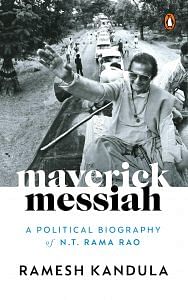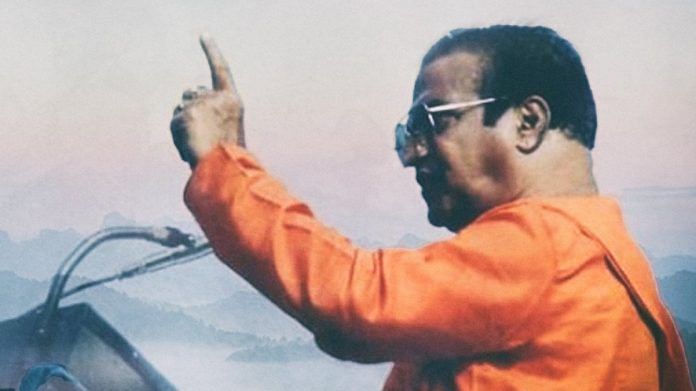The status of Telugu as the state’s official language was firmly established during NTR’s tenure. Telugu had always been the language of the people, but it received primacy in the administration after NTR took over the reins. Thereafter, the use of Telugu became widespread in all government functions and official events. NTR himself was a brand ambassador for the language. NTR’s identification with the native tongue elevated it to prominence in the administration.
His party had every document, statement and press note, including the party manifesto, released in flowery Telugu. The ruling party’s annual conventions were awash with Telugu historical and cultural ethos, and all its declarations and resolutions were invariably put out in the same language as well.
C. Narayana Reddy claimed that when he had told NTR in 1982 about Sri Krishnadevaraya’s famous poem on the prominence of Telugu language, the latter was not aware of it. Thrilled by the verse, ‘Desa Bhashalandu Telugu Lessa [Of all the languages of the country, Telugu is the best]’, NTR got it on a piece of paper and immediately memorized it. He would often recite the poem with great feeling to express his love for Telugu in public meetings.
NTR had a distinctly formal way of speaking Telugu with alliterative wordings. His Telugu was idiomatic but also Sanskritized. He had also a literary way of speaking. His poetic composition of dry sentences, reminiscent of dialogues in his mythological films, invested him with a Teluguness that people were familiar with. His public speeches, especially in meetings related to education and culture, were full of Telugu cultural motifs with quotes from well-known writers like Gurajada and Rayaprolu. No other politician of AP delivered such ornamental speeches, not even the more scholarly and erudite Narasimha Rao.
One of NTR’s real-life performances was as a priest, presiding over a wedding ritual in the Telugu tradition while he was the chief minister. NTR officiated a marriage in 1988 in the family of Telugu writer Nagabhairava Koteswara Rao, who had written dialogues for his film Brahmarshi Viswamitra. NTR was following the tradition of ‘Kamma Brahmins’ prevalent in the 1940s when some Kammas learnt the relevant mantras and officiated at weddings in their community. Effortlessly slipping into the role, NTR guided the ritual, explaining the meaning of the proceedings and elucidating the connotation behind each custom such as jeelakarra-bellam which is specific to Telugu marriages. Through such acts, NTR epitomized Teluguness.
Also read: N.T. Rama Rao, the three-time CM of Andhra Pradesh who could serve one full term
But he was not content in merely providing a psychological fillip to the status of the language. He went about systemically promoting the use of Telugu in governance. For the first time, orders were issued for implementing Telugu at all levels of administration from 1 November 1988, the State Formation Day. Training programmes were conducted for principal secretaries and below for making ‘file notings’ in Telugu under the aegis of the Official Language Commission headed by Narayana Reddy. The chief minister wanted all communication to the Centre to be carried out in Telugu, along with an English copy.
The Official Language Commission made a significant contribution during NTR’s tenure. Besides conducting training programmes, the commission prepared glossaries for thirty- four departments and a pocket-size dictionary, titled Karyalaya Padaavali, for general use with 1000 words and phrases. The commission, during the chairmanship of Nanduri Ramakrishna Acharya, ensured that 11,000 typists were trained in Telugu typing. The government set up Telugu vignana samachara kendralu (libraries) in all the districts. ‘We have to recognise the basic fact that the student can always learn in his own mother tongue more efficiently,’ NTR told a meeting of vice chancellors, suggesting to the universities to introduce Telugu as the medium of instruction even at the postgraduate level.36
NTR imprinted every government scheme with a ‘Telugu’ tag, starting from Telugu Ganga. He called, for example, distribution of land to the landless poor Telugu Maganam Samaradhana, scholarships for meritorious school students Telugu Vignana Parithoshakam, and an afforestation programme Telugu Vriksha Sankshema Pathakam. Financial help to build movie theatres was called Telugu Chalanachitra Kala Vikasam, and the scheme to create assets in rural areas was referred to as Telugu Grameena Kranthi Patham. Supply of dhotis and sarees at cheaper prices was referred to as Telugu Vastra Pradana Vidhanam; pension scheme for poor widows was termed Telugu Vitantu Upadhi Kalpanam; help to poor pregnant women was Telugu Matrudevatha Samadaram; and a health scheme for schoolchildren was called Telugu Chiranjeeva Sukheebhavam.
NTR’s penchant for naming all government schemes and policies in highly Sanskritized Telugu sometimes verged on being funny. A plan to provide public toilets for women was rather a mouthful: Telugu Mahila Bahirbhumi Pathakam. NTR, who extensively used pure Telugu words with Dravidian origins in his films, surprisingly chose pretentiously high-flown Sanskrit in government.
The famous Telugu Talli (Mother Telugu) statue near the secretariat was installed by his government. The 10.5-feet-tall bronze statue weighing 800 kg was sculpted by Devu Shankar at a cost of Rs 90,000 in 1986. NTR also took an interest in building Telugu architectural-style edifices in the secretariat as well as in the Telugu University campus, including Telugu Lalitha Kala Thoranam, an open-air theatre in Public Gardens.
Also read: Vijayanagara was more magnificent than Rome, and Krishnadevaraya India’s first global leader
The annual Mahanadu events of the TDP, coinciding with his birthday, overflowed with Telugu cultural traditions. Every Mahanadu had a ‘mela’-like atmosphere. A few hundred artists and performers participated in the cultural events, entertaining a sea of people who thronged the temporary venue throughout the week. Huge cut-outs, elaborately decorated venues, a big stage, engaging cultural shows, displays of traditional arts and crafts, and a rich variety of Andhra cuisine featured in these annual events. The who’s who of the Opposition graced these occasions. A stall on NTR’s film career was always a part of the event. The 1988 Mahanadu, which marked the completion of five years in power for the TDP, was a spectacular affair. Held in Vijayawada in a 100-acre area, it was as much a Telugu cultural extravaganza as it was a political meeting. Bullock cart races, kabaddi, wrestling and other rural sports entertained audiences at Satavahanapuri.37 The entry points, reflecting Telugu history, were called Dharanikota and Nagarjuna gateways. Telugu folk art forms such as Veedhi Bhagavatam, Tappeta Gullu, Kolatam, Harikatha, Burrakatha, Pagati Veshalu and Puli Veshalu were performed every evening. A mini zoo with a lion, a tiger, an elephant, deer and birds was set up as a special attraction. The stage, designed by film set designer Ketha, was called ‘Samyamanam [Fortitude]’. NTR liked to dazzle the who’s who of the national Opposition with such cultural and visual spectacles.
Though a Telugu lover, NTR was far from a linguistic fanatic. In one of the meetings of the Official Language Commission, many participants argued that all hearings in courts should be compulsorily in Telugu. NTR asked in which language the law course was being taught. ‘English,’ came the answer. ‘Then how can we insist them to argue court cases in Telugu, when we are not teaching law in Telugu? First, prepare all law textbooks in Telugu,’ he instructed.38
The credit for infusing Telugu language and culture into the ethos of Hyderabad mainly goes to NTR. Before him, the Deccani culture of the city reflected few traces of Telugu or Telangana. Even decades after the formation of AP with the merger of Andhra and Telangana regions, Hyderabad continued to be a Nawabi city, dominated by an Urdu and Nizami cultural milieu. Telugu had a lower standing among the languages spoken in the state capital for many historical reasons, though numerically the speakers were always in the majority. The elite of Telangana preferred to speak in Urdu to be counted among the aristocracy of the erstwhile princely state.
In Hyderabad, the elite would take pride in Deccani tehzeeb, which was considered a confluence of various cultures. But the reality was that Telugu, and its speakers, who constituted the majority in the Nizam kingdom (Hyderabad state), were looked down upon. Urdu was the official language, Farsi, Persian and Arabic had a pride of place, and even Marathi enjoyed a better status. In fact, a Lucknowi or a Punjabi would have felt more at home in Hyderabad than a Telugu from coastal Andhra or interior Telangana. ‘It was amusing to note that in the heart of the capital of a Telugu-speaking State, Telugu didn’t always work,’ recalled Narendra Luther, a former civil servant who authored several books on Hyderabad.39 While Telangana festivals like Bonalu or Bathukamma were celebrated in the city, they were looked down upon as working-class carnivals. As for people from coastal Andhra and Rayalaseema, they did not exactly feel at home in the capital of their own state due to the cultural and linguistic alienation.
It was against this backdrop that NTR’s arrival on the scene made a significant difference to Hyderabad’s cultural landscape. For the first time since Hyderabad became their capital in 1956, the middle classes from coastal Andhra and Rayalaseema regions felt an emotional connection to the city. This was a direct outcome of NTR’s linguistic nationalism.
 This excerpt from ‘Maverick Messiah: A Political Biography of N.T. Rama Rao’ by Ramesh Kandula has been published with permission from Penguin Random House India.
This excerpt from ‘Maverick Messiah: A Political Biography of N.T. Rama Rao’ by Ramesh Kandula has been published with permission from Penguin Random House India.




This is absurd argument, at the cost of telugu for 400 years urdu was thrusted on Telugus mostly hindus in nizam ruled areas. The muslim/urdu geographical spread or population percentage is very less but it was forcibly thrusted on telangana and nizam ruled areas. That forceble r*ape of telugu language was stopped by NTR. By taking pride in telugu patronage . Pl don’t subvert the history with appeasement indian secular standard . Thank you
This fellow misrepresenting facts. Every one in the state know that after NTR Telugu got prominace in Telangana area. Before, NTR rule, we people experienced that was difficult for us to understand local dilect mix with several Urdu words. After NTR rule we experienced no difficulty as people learnt to speak Telugu. Now the situation is very comfortable to Telugu speaking people.
The author appears to be a fanatic, lunatic, otherwise, he would understand the reality. He might be hallucinating.
The print should not have published an article of a man with dubious distinction
This article is about telugu that’s write in english
I referred in my above comment the following portion of the article as absurd.
“C. Narayana Reddy claimed that when he had told NTR in 1982 about Sri Krishnadevaraya’s famous poem on the prominence of Telugu language, the latter was not aware of it”.
Awesome. Long live Telugu!
Kudos to NTR.
Not just a pretty face then!
Thank you for this gem and heartfelt thank you to our leader NTR for establishing the primacy of our culture heritage and our language.
The prevailing tehzeeb was and is an outlier and needs to wiped off from this land.
It reminds me of enslavement of rich society and community by jihadi wahabi tribal fundamentalism.
This is absurd. He acted in Mahamantri Timmarasu in 1960s where as Krishnadevaraya he in Ghantasala’s voice he recites this poem. So to say that NTR didn’t know the poem amounts to blasphemy. How can you publish this type of rubbish without ascertaining facts?
Absolutely correct! I don’t know who edit these pieces before it goes appears in the edition. Very poor.